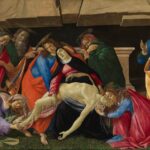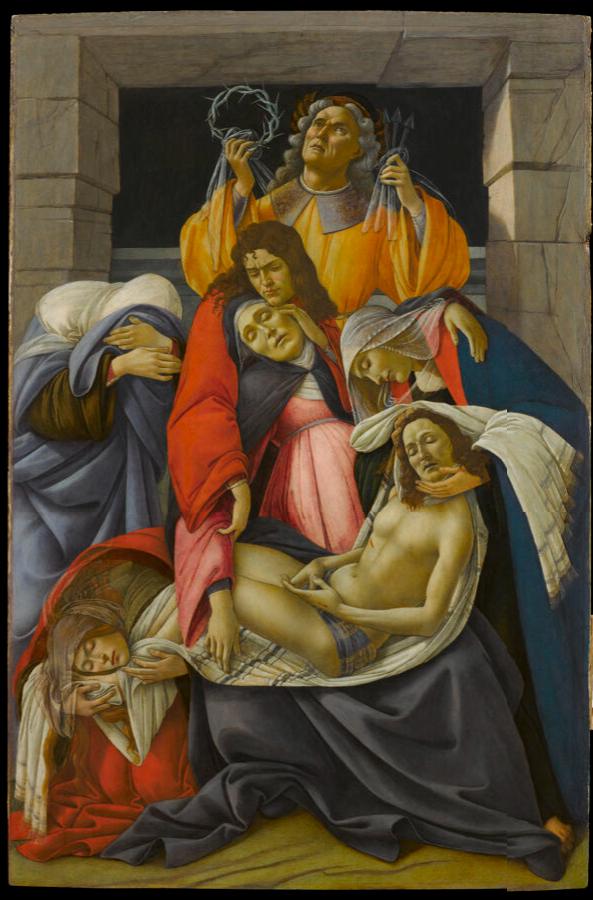Botticelli, Sandro (c.1445-1510)
Compianto sul Cristo morto (Lamentation over the Dead Christ)
c.1495–1500
Tempera on wood, 106 x 71 cm
Museo Poldi Pezzoli, Milano
The painting, one of the most dramatic realizations of Sandro Botticelli‘s late activity, depicts the moment in which Jesus is transported to the tomb. In the foreground the body of Christ lies on the knees of the Madonna, who has fainted and is supported by Saint John the Evangelist. Mary Magdalene, also in red like Saint John, embraces Jesus’ feet and her eyes are closed. The other two pious women are depicted on the right and left of the table: the first of hers supports the Savior’s head, while the second of hers, in a grip of despair, hides her face in her mantle. In the background, silhouetted against the black background, which alludes to the tomb carved into the rock, stands Joseph of Arimathea: his raised hands show off the crown of thorns and the nails of the cross, while his gaze, turned upwards, leads the sense of earthly drama to the inscrutable divine design. The table shows the stylistic turning point that Botticelli‘s painting underwent from the early nineties of the fifteenth century in relation to the new, intense religious sentiment aroused in him by the ascetic preaching of the Dominican friar Gerolamo Savonarola who invested the whole city of Florence. Savonarola’s appeal to a more severe and participatory religiosity, together with the disorientation caused by the death of Lorenzo de’ Medici, lord of Florence and great patron of the arts, which took place in 1492, determined a state of profound spiritual restlessness in the artist. The painting, created around 1495, belongs to a late phase in the artist’s production, characterized by the contrast between the world of humanistic culture, with its courteous and pagan components, and that of the ascetic and reforming rigor of Savonarola, which brought Botticelli to an afterthought and a mystical crisis, evident in his works, in which the subjects, almost exclusively religious, become increasingly introspective, and the scenes become more unreal. The elaborate and complex composition is very dramatic and is characterized by a rhythm fragmentary and syncopated. The figures that gather around Christ form a compact group; their eyes are closed, or covered by their hands, because they are unable to sustain the sight of that lifeless body. The pose of Christ seems to derive from that of the dead Meleager carved on the homonymous sarcophagus of Villa Doria Pamphilj in Rome. The expressive and gestural forcings and the use of only primary colors (blue, red and yellow) as violent chromatic ignitions, accentuate the pathos of the scene, in which Botticelli shows that he has abandoned the grace and serenity of his first works. There is a freer disposition of subjects in space which heralds a new sensibility which will spread in the sixteenth century. The composition achieves an extraordinary visual effectiveness thanks to the concatenation of the arms of the Virgin and Saint John and to the exceptional role that the arrangement of the hands assumes in the rhythm of the image. On the pictorial surface the artist spread gold highlights with great profusion. The Lamentation of Poldi Pezzoli has been identified with the altarpiece of a small funerary altar leaning against a pillar of the Florentine church of Santa Maria Maggiore, still present in the mid-sixteenth century . Documentary traces of the panel are lost in the eighteenth century, before it was purchased by Gian Giacomo Poldi Pezzoli on March 12, 1879, only a month and a half before the collector’s death. The work is contemporary with the Mystical Crucifixion in the Fogg Art Museum in Cambridge, Mass. (inv. 1924.7), and some time later than the Lamentation over the Dead Christ in the Alte Pinakothek in Munich, which develops the same theme but horizontally. (MPP)
Compare:
 Botticelli, Sandro (c.1445-1510)
Botticelli, Sandro (c.1445-1510)
Compianto sul Cristo morto
c.1490–1495
Alte Pinakothek, Munich
